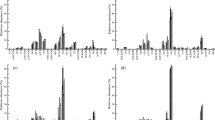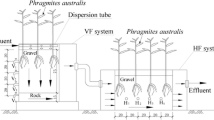Abstract
In order to investigate the treatment performance and microorganism mechanism of IVCW for domestic wastewater in central of China, two parallel pilot-scale IVCW systems were built to evaluate purification efficiencies, microbial community structure and enzyme activities. The results showed that mean removal efficiencies were 81.03 % for COD, 51.66 % for total nitrogen (TN), 42.50 % for NH4 +-N, and 68.01 % for TP. Significant positive correlations between nitrate reductase activities and TN and NH4 +-N removal efficiencies, along with a significant correlation between substrate enzyme activity and operation time, were observed. Redundancy analysis demonstrated gram-negative bacteria were mainly responsible for urease and phosphatase activities, and also played a major role in dehydrogenase and nitrate reductase activities. Meanwhile, anaerobic bacteria, gram-negative bacteria, and saturated FA groups, gram-positive bacteria exhibited good correlations with the removal of COD (p = 0.388), N (p = 0.236), and TP (p = 0.074), respectively. The IVCW system can be used to treat domestic wastewater effectively.










Similar content being viewed by others
References
Abdelmagid HM, Tabatabai MA (1987) Nitrate reductase activity of soils. Soil Biol Biochem 19:421–427
Ahn C, Gillevet PM, Sikaroodi M (2007) Molecular characterization of microbial communities in treatment microcosm wetlands as influenced by macrophytes and phosphorus loading. Ecol. Indicat 7:852–863
Akratos CS, Tsihrintzis VA (2007) Effect of temperature, HRT, vegetation and porous media on removal efficiency of pilot-scale horizontal subsurface flow constructed wetlands. Ecol Eng 29(2):173–191
Allison VJ, Condron LM, Peltzerc DA, Richardsonc SJ, Turner BL (2007) Changes in enzyme activities and soil microbial community composition along carbon and nutrient gradients at the Franz Josef chronosequence. New ZealandSoil Biol. Biochem 39:1770–1781
Billore SK, Singh N, Sharma JK, Dass P, Nelson RM (1999) Horizontal subsurface flow gravel bed constructed wetland with Phragmites Karka in central India. Water Sci Technol 40:163–171
Calheiros CSC, Duque AF, Moura A, Henriques IS, Correia A, Rangel AOSS, Castro PML (2009) Changes in the bacterial community structure in two-stage constructed wetlands with different plants for industrial wastewater treatment. Bioresour Technol 100:3228–3235
Chang J, Wu S, Dai Y, Liang W, Wu Z (2012) Treatment performance of integrated vertical-flow constructed wetland plots for domestic wastewater. Ecol Eng 44:152–159
Chung AKC, Wu Y, Tam NFY, Wong MH (2008) Nitrogen and phosphate mass balance in a sub-surface flow constructed wetland for treating municipal wastewater. Ecol Eng 32:81–89
D’Angelo EM, Karathanasis AD, Sparks EJ, Ritchey SA, Wehr-McChesney SA (2005) Soil carbon and microbial communities at mitigated and late successional bottomland forest wetlands. Wetlands 25:162–175
Dong Y, Wiliński PR, Dzakpasu M, Scholz M (2011) Impact of hydraulic loading rate and season on water contaminant reductions within integrated constructed wetlands. Wetlands 31:499–509
Duarte B, Reboreda R, Cacdor I (2008) Seasonal variation of extracellular enzymatic activity (EEA) and its influence on metal speciation in a polluted salt marsh. Chemosphere 73:1056–1063
Faulwetter JL, Gagnon V, Sundberg C, Chazarenc F, Burr MD, Brisson J, Camper AK, Stein OR (2009) Microbial processes influencing performance of treatment wetlands: a review. Ecol Eng 35:987–1004
Fountoulakis MS, Terzakis S, Chatzinotas A, Brix H, Kalogerakis N, Manios N (2009) Pilot-scale comparison of constructed wetlands operated under high hydraulic loading rates and attached biofilm reactors for domestic wastewater treatment. Sci Total Environ 407:2996–3003
Gikas GD, Tsihrintzis VA, Akratos CS (2011) Performance and modeling of a vertical flow constructed wetland—maturation pond system. J. Environ. Sci. Health A 46(7):692–708
Gikas GD, Tsihrintzis VA (2012) A small-size vertical flow constructed wetland for on-site treatment of household wastewater. Ecol Eng 44:337–343
Huang J, Reneau JRRB, Hagedorn C (2000) Nitrogen removal in constructed wetlands employed to treat domestic wastewater. Water Res 34:2582–2588
Kent AD, Yannarell AC, Rusak JA, Triplett EW, McMahon KD (2007) Synchrony in aquatic microbial community dynamics. ISME J 1:38–47
Klose S, Tabatabai MA (2000) Urease activity of microbial biomass in soils as affected by cropping systems. Biol. Fert. Soils 31:191–199
Kotti EP, Gikas GD, Tsihrintzis VA (2010) Effect of temperature, HRT, vegetation and porous media on removal efficiency of pilot-scale free water surface flow constructed wetlands. Ecol Eng 36(7):862–875
Krasnits E, Friedler E, Sabbah I, Beliavski M, Tarre S, Green M (2009) Spatial distribution of major microbial groups in a well established constructed wetland treating municipal wastewater. Ecol Eng 35:1085–1089
Kuschk P, Wiebner A, Kappelmeyer U, Weibbrodt E , Kastner M, Stottmeister U (2003) Annual cycle of nitrogen removal by a pilot-scale subsurface horizontal flow in a constructed wetland under moderate climate. Water Res 37:4236–4242
Leps J, Smilauer P (2003) Multivariate analysis of ecological data using CanocoTM. Cambridge University Press, Cambridge, p 62
Liang W, Wu Z, Cheng S, Zhou Q, Hu H (2003) Roles of substrate microorganisms and urease activities in wastewater purification in a constructed wetland system. Ecol Eng 21:191–195
Li S, Li H, Liang XQ, Chen YX, Cao ZH, Xu ZH (2009) Rural wastewater irrigation and nitrogen removal by the paddy wetland system in the Tai Lake region of China. J. Soils. Sediments 9:433–442
Li YH, Li HB, Wang X, Sun TH (2011) Changes in microbial populations and enzyme activities during nitrogen biodegradation of domestic sewage treatment in the subsurface wastewater infiltration system (SWIS). Bull Environ Contam Toxicol 87:431–435
Martens DA, Johanson JB, Frankenberger WT (1992) Production and persistence of soil enzymes with repeated addition of organic residues. Soil Sci 153:53–61
Mentzer JL, Goodman RM, Balser TC (2006) Microbial response over time to hydrologic and fertilization treatments in a simulated wet prairie. Plant Soil 284:85–100
Mina IPO, Costa M, Matos A, Calheiros CSC, Castro PML (2011) Polishing domestic wastewater on a subsurface flow constructed wetland: organic matter removal and microbial monitoring. Int. J. Phytorem 13:947–958
van de Moortel AMK, Rousseau DPL, Tack FMG, Pauw ND (2009) A comparative study of surface and subsurface flow constructed wetlands for treatment of combined sewer overflows: a greenhouse experiment. Ecological Engineering 35:175–183
Pankhurst CE, Yu S, Hawke BG et al (2001) Capacity of fatty acid profiles and substrate utilization patterns to describe differences in soil microbial communities associated with increased salinity or alkalinity at three locations in South Australia. Biol. Fertil. Soils 33:204–217
Perfler R, Laber J, Langergraber G, Haberl R (1999) Constructed wetlands for rehabilitation and reuse of surface waters in tropical and subtropical areas—first results from small-scale plots using vertical flow beds. Water Sci Technol 40(3):155–162
Saeed T, Sun GZ (2011) Enhanced denitrification and organics removal in hybrid wetland columns: comparative experiments. Bioresour Technol 102:967–974
Schinner F, von Mersi W (1990) Xylanase-, CM-cellulase- and invertase activity in soil: an improved method. Soil. Biol. Biochem 22:511–515
Schutter ME, Dick RP (2000) Comparison of fatty acid methyl ester (FAME) methods for characterizing microbial communities. Soil Sci Soc Am J 64:1659–1668
Smith J, Wagner-Riddle C, Dunfield K (2010) Season and management related changes in the diversity of nitrifying and denitrifying bacteria over winter and spring. Appl Soil Ecol 44:138–146
State Environmental Protection Administration of China (2002) Standard methods for testing water and wastewater, 4th edn. China Environment Science Press, Beijing
Steenwerth KL, Jackson LE, Carlisle EA, Scow KM (2006) Microbial communities of a native perennial bunchgrass do not respond consistently across a gradient of land-use intensification. Soil Biol Biochem 38:1797–1811
Stefanakis AI, Tsihrintzis VA (2012) Effect of loading, resting period, temperature, porous media, vegetation and aeration on performance of pilot-scale vertical flow constructed wetlands. Chem Eng J 181–182:416–430
Tabatabai MA (1994) Soil enzymes. In: Weaver RW, Angel JS, Bottomley PS (eds) Methods of soil analysis, part 2-microbiological and biochemical properties. SSSA Book Series No. 5. Soil Science Society of America, Madison, pp 775–833
ter Braak CJF (1994) Canonical community ordination: part I. Basic theory and linear methods. Ecoscience 1:127–140
Tsihrintzis VA, Gikas GD (2010) Constructed wetlands for wastewater and activated sludge treatment in north Greece: a review. Water Sci Technol 61(10):2653–2672
Vymazal J (2002) The use of sub-surface constructed wetlands for wastewater treatment in the Czech Republic: 10 years experience. Ecol Eng 18:633–646
Wang LM, Guo FH, Zheng Z, Luo XZ, Zhang JB (2011) Enhancement of rural domestic sewage treatment performance, and assessment of microbial community diversity and structure using tower vermifiltration. Bioresour Technol 102:9462–9470
Weaver MA, Zablotowicz RM, Krutz LJ, Bryson CT, Locke MA (2012) Microbial and vegetative changes associated with development of a constructed wetland. Ecol Indic 13:37–45
Wilkinson SG (1988) Gram negative bacteria. In: Ratledge C and Wilkinson SG (eds) Microbial Lipids. Academic Press, London, pp. 299–488
Wright AL, Reddy KR (2001) Phosphorus loading effects on extracellular enzyme activity in everglades wetland soils. Soil Sci Soc Am J 65:588–595
Wu HM, Zhang J, Li PZ et al (2011) Nutrient removal in constructed microcosm wetlands for treating polluted river water in northern China. Ecol. Eng 37:560–568
Xiong JB, Qin Y, Mahmood Q, Liu HH, Yang DJ (2011) Phosphorus removal from secondary effluents through integrated constructed treatment system. Mar Pollut Bull 63:98–101
Zelles I, Bai QY, Beck T, Beese F (1992) Signature fatty acids in phospholipids and lipopolysaccharides as indicators of microbial biomass and community structure in agricultural soils. Soil Biol Biochem 24:317–323
Zelles L (1999) Fatty acid patterns of phospholipids and lipopolysaccharides in the characterization of microbial communities in soil: a review. Biol Fertil Soils 29:111–129
Zhang CB, Huang LN, Luan TG, Jin J, Lan CY (2006) Structure and function of microbial community during the early stages of revegetation near Shaoguan Pb/Zn Smelter, Guangdong, P.R. China. Geoderma 136:555–565
Zhang CB, Liu WL, Wang J, Chen T, Yuan QQ, Huang CC, Ge Y, Chang SX, CHANG J (2011) Plant functional group richness-affected microbial community structure and function in a full-scale constructed wetland. Ecol. Eng 37:1360–1368
Zhang CB, Wang J, Liu WL, Zhu SX, Ge HL, Chang SX, Ge Y, Chang J (2010) Effects of plant diversity on microbial biomass and community metabolic profiles in a full-scale constructed wetland. Ecol Eng 36:62–68
Zhang D, Gersberg RM, Keat TS (2009) Constructed wetlands in China. Ecol Eng 35(10):1367–1378
Zhao YJ, Hui Z, Chao X, Nie E, Li HJ, He J, Zheng Z (2011) Efficiency of two-stage combinations of subsurface vertical down-flow and up-flow constructed wetland systems for treating variation in influent C/N ratios of domestic wastewater. Ecol Eng 37:1546–1554
Zhou QH, He F, Zhang LP, Wang YF, Wu ZB (2009) Characteristics of the microbial communities in the integrated vertical-flow constructed wetlands. J. Environ. Sci. China 21:1261–1267
Acknowledgments
This work was supported by grants from National Natural Science Foundation of China (51179184, 41272272), Key Project of the National Twelfth-Five Year Research Program of China (2012BAD25B05-02), Major Science and Technology Program for Water Pollution Control and Treatment (2011ZX07303-001).
Author information
Authors and Affiliations
Corresponding author
Additional information
Responsible editor: Robert Duran
Rights and permissions
About this article
Cite this article
Wu, Sq., Chang, Jj., Dai, Y. et al. Treatment performance and microorganism community structure of integrated vertical-flow constructed wetland plots for domestic wastewater. Environ Sci Pollut Res 20, 3789–3798 (2013). https://doi.org/10.1007/s11356-012-1307-0
Received:
Accepted:
Published:
Issue Date:
DOI: https://doi.org/10.1007/s11356-012-1307-0




